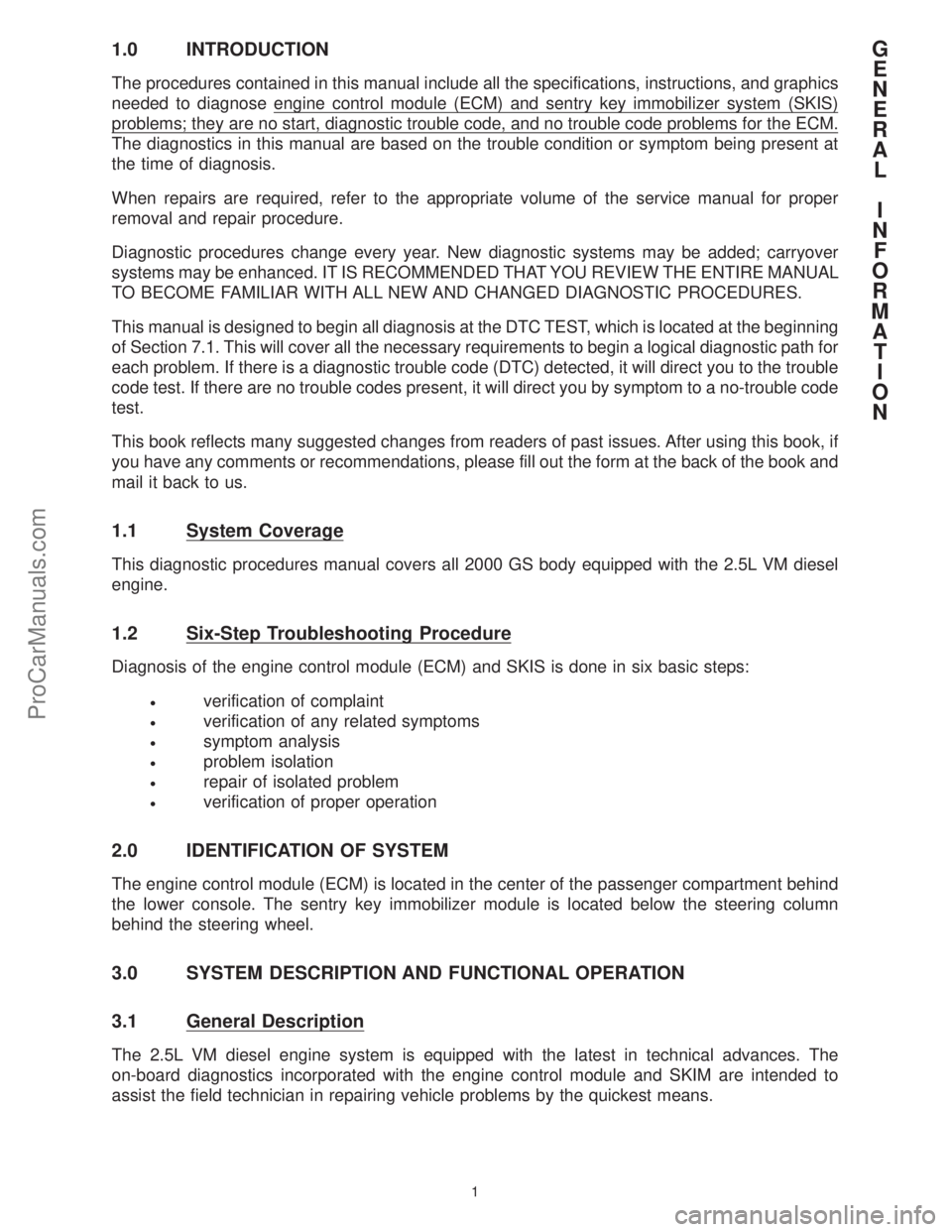technical specifications CHRYSLER CARAVAN 2000 Service Manual
[x] Cancel search | Manufacturer: CHRYSLER, Model Year: 2000, Model line: CARAVAN, Model: CHRYSLER CARAVAN 2000Pages: 436, PDF Size: 3.4 MB
Page 7 of 436

1.0 INTRODUCTION
The procedures contained in this manual include all the specifications, instructions, and graphics
needed to diagnose engine control module (ECM) and sentry key immobilizer system (SKIS)
problems; they are no start, diagnostic trouble code, and no trouble code problems for the ECM.
The diagnostics in this manual are based on the trouble condition or symptom being present at
the time of diagnosis.
When repairs are required, refer to the appropriate volume of the service manual for proper
removal and repair procedure.
Diagnostic procedures change every year. New diagnostic systems may be added; carryover
systems may be enhanced. IT IS RECOMMENDED THAT YOU REVIEW THE ENTIRE MANUAL
TO BECOME FAMILIAR WITH ALL NEW AND CHANGED DIAGNOSTIC PROCEDURES.
This manual is designed to begin all diagnosis at the DTC TEST, which is located at the beginning
of Section 7.1. This will cover all the necessary requirements to begin a logical diagnostic path for
each problem. If there is a diagnostic trouble code (DTC) detected, it will direct you to the trouble
code test. If there are no trouble codes present, it will direct you by symptom to a no-trouble code
test.
This book reflects many suggested changes from readers of past issues. After using this book, if
you have any comments or recommendations, please fill out the form at the back of the book and
mail it back to us.
1.1 System Coverage
This diagnostic procedures manual covers all 2000 GS body equipped with the 2.5L VM diesel
engine.
1.2 Six-Step Troubleshooting Procedure
Diagnosis of the engine control module (ECM) and SKIS is done in six basic steps:
²verification of complaint
²verification of any related symptoms
²symptom analysis
²problem isolation
²repair of isolated problem
²verification of proper operation
2.0 IDENTIFICATION OF SYSTEM
The engine control module (ECM) is located in the center of the passenger compartment behind
the lower console. The sentry key immobilizer module is located below the steering column
behind the steering wheel.
3.0 SYSTEM DESCRIPTION AND FUNCTIONAL OPERATION
3.1 General Description
The 2.5L VM diesel engine system is equipped with the latest in technical advances. The
on-board diagnostics incorporated with the engine control module and SKIM are intended to
assist the field technician in repairing vehicle problems by the quickest means.
G
E
N
E
R
A
L
I
N
F
O
R
M
A
T
I
O
N
1
ProCarManuals.com
Page 373 of 436

TEST NTC-12ACHECKING THE ENGINE MECHANICAL SYSTEMS
Perform TEST NTC-1A Before Proceeding
At this point in the diagnostic test procedure, you have determined that all of theengine electrical
systemsare operating as designed; therefore, theyare not the cause of the driveability problem.
The following additional items should be checked as possible mechanical causes of the problem.
1. ENGINE VALVE TIMING- must be within specifications
2. ENGINE COMPRESSION- must be within specifications
3. CAMSHAFT LOBES- check for abnormal wear
4. ENGINE SPEED SENSOR PICK-UP- check flywheel slots for debris/deterioration
5. ENGINE EXHAUST SYSTEM- must be free of any restrictions
6. ENGINE DRIVE SPROCKET- must be properly positioned
7. POWER BRAKE BOOSTER- no internal vacuum leaks
8. FUEL- must be free of contamination
9. FUEL INJECTOR- plugged or restricted injector
10. FUEL INJECTION PUMP- must be properly timed
NOTE:Always look for any Technical Service Bulletins that may relate to the problem.
N
O
T
R
O
U
B
L
E
C
O
D
E
T
E
S
T
S
367
ProCarManuals.com
Page 424 of 436

TEST NS-4AREPAIRING A START AND STALL CONDITION
Perform TEST NS-SEL Before Proceeding
At this point in the diagnostic test procedure it is assumed that all of the engine electrical systems
are operating as designed and are not the cause of a start and stall, or a no start problem. The
following additional items should be checked as possible mechanical problems. Any one of these
items can produce a start and stall, or no start condition; none can be overlooked as a possible
cause.
1. ENGINE VALVE TIMINGÐ must be within specifications
2. ENGINE COMPRESSIONÐ must be within specifications
3. ENGINE EXHAUST SYSTEMÐ must be free of any restrictions
4. FUELÐ must be free of contamination
5. FUEL FILTERÐ must be free of any restrictions
6. INTAKE AIR DUCTÐ passages must be free of any debris
Always look for any Technical Service Bulletins that may relate to this problem.
N
O
S
T
A
R
T
T
E
S
T
S
418
ProCarManuals.com